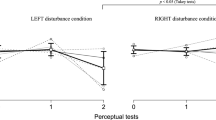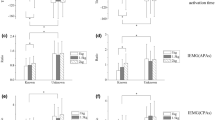Abstract
This paper proposes a theoretical model of the control and perception mechanism in human balance. Human balance perception is evaluated by the subjective upright posture, the posture at which a person does not feel he/she is at an incline. Our balance experiments in the seated posture showed that the subjective upright posture changed after the balancing task where the participants needed to incline to maintain their balance. This paper aimed to explain this adaptive phenomenon by reproducing the experimental results using computer simulations. Hypothesizing that “humans gradually come to recognize the posture they need to take to maintain their balance as being upright,” an adaptation rule for subjective upright posture is defined, so that it approaches the averaged posture in the period of the balancing task. For the balance control, center of pressure feedback is adopted. As a result, the similar changes in subjective upright posture are simulated with a two-link model with a base link, implying that our hypothesis is one possible explanation on the mechanism for human balance control and perception.









Similar content being viewed by others
References
Barbeau H (2003) Locomotor training in neurorehabilitation: emerging rehabilitation concepts. Neurorehabilit Neural Rep 17(1):3–11
Ito S, Kawasaki H (2005) Regularity in an environment produces an internal torque pattern for biped balance control. Biol Cybern 92(4):241–251
Ito S, Ishikawa Y, Minoru S (2014) Experiments on perceptual change accompanying motor learning in seated balance. Trans SICE 50(12):852–860 in Japanese
Kawato M (1996) Computational theory of brain. Sangyo Tosho (in Japanese)
Kumagai S, Ito S, Matsushita K, Sasaki M (2015) The balance perception changes by motor learning with active trunk movements. In: Proceedings of 2015 IEEE/SICE international symposium on system integration (SII2015) pp 936–941
Kumagai S, Morita R, Ito S (2017) Analysis and evaluation of equilibrium motor learning in seated state and its relation to accompanying perceptual changes in subjective upright posture. Trans Soc Instrum Control Eng 53(12):654–662 in Japanese
Luyat M, Gentaz E, Corte TR, Guerraz M (2001) Reference frames and haptic perception of orientation: body and head tilt effects on the oblique effect. Percept Psychophys 63(3):541–554
MacKay-Lyons M (2002) Central pattern generation of locomotion: a review of the evidence. Phys Ther 82(1):69–83
Mittelstaedt H (1983) A new solution to the problem of the subjective vertical. Naturwissenschaften 70(6):272–281
Oña ED, Cano-de la Cuerda R, Sánchez-Herrera P, Balaguer C, Jardón A (2018) A review of robotics in neurorehabilitation: towards an automated process for upper limb. J Healthc Eng 2018:9758939
Ostry DJ, Darainy M, Mattar AA, Wong J, Gribble PL (2010) Somatosensory plasticity and motor learning. J Neurosci 30(15):5384–5393
Ramadan A, Cholewicki J, Radcliffe CJ, Popovich JM Jr, Reeves NP, Choi J (2017) Reliability of assessing postural control during seated balancing using a physical human–robot interaction. J Biomech 64:198–205
Shadmehr R, Mussa-Ivaldi FA (1994) Adaptive representation of dynamics during learning of a motor task. J Neurosci 14(5):3208–3224
Taylor M, Creelman CD (1967) Pest: efficient estimates on probability functions. J Acoust Soc Am 41(4A):782–787
Wedtgrube A, Bockisch C, Tarnutzer A (2020) Effects of prolonged roll-tilt on the subjective visual and haptic vertical in healthy human subjects. J Vestib Res 30(1):1–16
Author information
Authors and Affiliations
Corresponding author
Ethics declarations
Conflict of interest
The authors declare that they have no conflict of interest.
Additional information
Communicated by Benjamin Lindner.
Publisher's Note
Springer Nature remains neutral with regard to jurisdictional claims in published maps and institutional affiliations.
A part of this work was supported by Grant-in-Aid for Scientific Research(B) (No. 16H02879) of Japan Society for the Promotion of Science.
Appendices
Appendices
Motion equation
The Newton–Euler method provides the following motion equations for the mechanical model in Fig. 7.
where \(F_x\) and \(\tau _S\) are the control input of the stool defining the experimental conditions, as shown in Sect. B, and \(\tau _1\) and \(tau_2\) are the control input given as (1) and (2), respectively.
Additionally, \(f_Y\), \(f_\theta \), \(f_{0X}\), \(f_{0Y}\), \(f_{1X}\), \(f_{1Y}\), \(f_{2X}\) and \(f_{2Y}\) are the internal forces to constrain the links, which are calculated based on the following constraints, respectively. The stool motion is horizontal:
The base link does not relatively move on the stool, implying there are no rotations around the virtual joint,
and that the position of the virtual joint \((X_{J}, Y_{J})\), calculated from the seat position \((X_S, Y_S)\) and the base link \((X_0, Y_0)\) takes the same values in the no slipping condition:
Additionally, two joint positions are the same, even if they are calculated from both connected links.
Stool motion
The simulations were conducted in the same disturbance condition as the human experiments in Sect. 2.
To simulate 8 s, 0.2 m slide of the stool, \(F_0\) was defined as follows:
where \(K_{\mathrm{ds}}\) and \(K_{\mathrm{ps}}\) are the feedback gains and \(X_{\mathrm{ds}}\) is a desired position given by
Here, \(A=0.1\) m, \(T_c=8\) s, \(\rho = +1\) in the RIGHT condition, whereas \(\rho = -1\) in the LEFT condition.
However, the rotation disturbance is defined as follows:
where \(K_{\mathrm{ds}}\) and \(K_{\mathrm{ps}}\) are the feedback gains, usually set large values for stabilization, and \(\theta _{\mathrm{ds}}\) corresponds to a desired position given by
Here, \(K_{\theta }\) is a parameter controlling the speed of the seat surface rotation, usually set a comparatively small value to avoid rapid rotations for the safety, \(x_\mathrm{v}\) is a position of the virtual rotation axis that varies following the next equation in every 8 s
where \(t_\mathrm{p}\) (\(0 \le t_\mathrm{p} < 8\)) is the time in each trial. These equations destabilize the seat surface rotation. Actually, if the CoP is controlled to just above the virtual rotation axis, i.e., \(x_{\mathrm{CoP}}=x_\mathrm{v}\), the seat surface is stabilized at \(\theta _{\mathrm{ds}}\) since \(\theta _{\mathrm{ds}}\) never changes. However, if the CoP position is located to the right of the virtual rotation axis, i.e., \(x_{\mathrm{CoP}}>x_v\), then the seat will rotate to the right since \(\theta _{\mathrm{d}0}\) increases. Note that we set a constant desired angle \(\theta _{\mathrm{ds}} =0\), in case of no rotational disturbance.
In the simulation, the feedback gains are set as \(K_{\mathrm{dx}}=100\), \(K_{\mathrm{px}}=1500\), \(K_{\mathrm{ds}}=100\), \(K_{\mathrm{ps}}=3000\), and \(K_{\theta }=0.1\), Those are selected so that the link model can always keep the stability as well as the change of the perceptual upright posture \(\phi \) becomes the same order as that of the human measurement result in Fig. 5, i.e., around 0.01 m.
CoP position
At the CoP, the total moment from the ground reaction force becomes the CoP position. Thus, \(P_{\mathrm{CoP}}\) is provided as follows:
where
Results in our previous study
The last section briefly summarizes the results of our previous studies (mainly Kumagai et al. 2017) to explain how we came to consider there will be some relationship between subjective upright posture and the upper body posture during the motor learning phase.
This paper firstly reported several kinds of human experimental results with the same motor learning in Sect. 2.3, where only the control experiment was different. Most noticeable one is that the perceptual upright posture shifted to the opposite direction to the disturbance for the control experiments during which the participants just sit still on the stable stool. Because this result conflicted the ones based on this paper, we considered there would be some reasons behind these results: one candidate was the effect of the control experiment, and the other was the performance of the motor learning. To begin with the former, we conducted with the modified control experiment with stable stool, e.g., displaying the rolling spiral on the HMD or adding lateral shift of the stool with inward rotation to fix the spatial head position. Unfortunately, we did not obtain the result as we predicted. Further studies were required.
Next, we investigated the latter, the posture during the motor learning phase: the averaged roll angle of the seat, the relative phase of the CoP with respect to the virtual rotation axis, and the averaged horizontal deviation of the torso during 100 trials were analyzed for available ten participants. Because the task might be difficult for many subjects, the results were not uniform and thus different in participants. However, it seemed to be categorized to a few patterns.
To remove the data including insufficient learning effect, the phase shift of CoP was evaluated. If the participants learned a new experimental condition given as the periodic rotational disturbance created by the virtual rotation axis, the phase delay from the motion of the virtual rotation axis should decrease with the trials. Thus, three data where the relative phase of the CoP was getting larger were removed.
The rest seven data were able to be divided to two groups based on the trunk (torso) deviation except one data: In the first group of five participants, the trunk deviation was large in comparison with the average of ten participants, and its direction was the same as the disturbance (shift direction of the virtual rotation axis), while the trunk deviation was small and opposite in the second group of two participants.
This categorization brought us the following idea: the participants in the first group must take the posture in Fig. 10a to make the trunk deviation large, and then the subjective upright posture shifted to the same direction as the disturbance. So does it as for the second group based on Fig. 10b. In other words, we can expect that the subjective upright posture gradually changes toward the side to which the trunk leans during the motor learning, and our hypothesis in Sect. 2.1 was deduced. This paper attempted to theoretically explain the behavior of the first group and propose it as one of the possible models of human balance control. Note that, however, we have not obtained the evidence of this hypothesis yet.
Rights and permissions
About this article
Cite this article
Ito, S., Tomabechi, K. & Morita, R. Perceptual adaptation during a balancing task in the seated posture and its theoretical model. Biol Cybern 115, 207–217 (2021). https://doi.org/10.1007/s00422-021-00873-x
Received:
Accepted:
Published:
Issue Date:
DOI: https://doi.org/10.1007/s00422-021-00873-x





